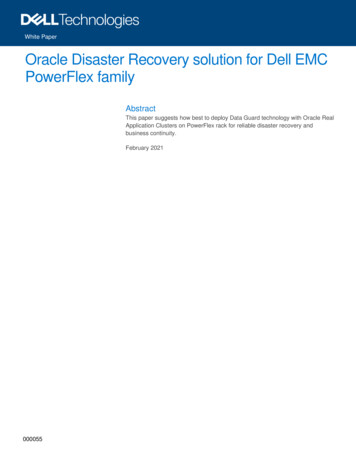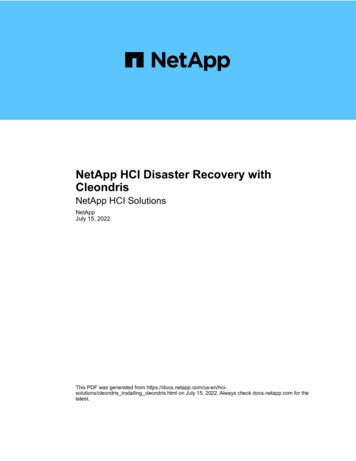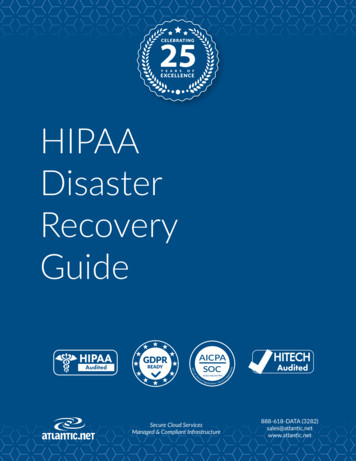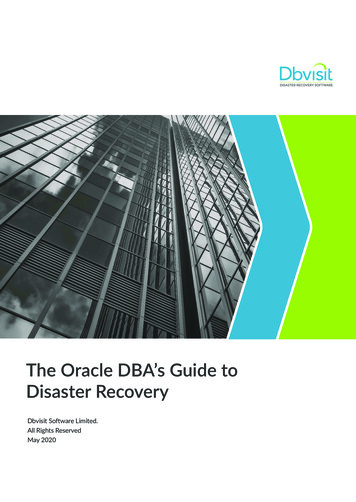
Transcription
White PaperOracle Disaster Recovery solution for Dell EMCPowerFlex familyAbstractThis paper suggests how best to deploy Data Guard technology with Oracle RealApplication Clusters on PowerFlex rack for reliable disaster recovery andbusiness continuity.February 2021000055
RevisionsRevisionsDateDescriptionOctober 2019Initial releaseFebruary 2021Updated VxFlex to PowerFlex as per new re-branding guidelinesAcknowledgementsThis paper was produced by the following:Author: Sanjay PuttaswamyContributors: Shashikir Chidambara and Neil GerrenThe information in this publication is provided “as is.” Dell Inc. makes no representations or warranties of any kind with respect to the information in thispublication, and specifically disclaims implied warranties of merchantability or fitness for a particular purpose.Use, copying, and distribution of any software described in this publication requires an applicable software license.Copyright 2021 Dell Inc. or its subsidiaries. All Rights Reserved. Dell, EMC, Dell EMC and other trademarks are trademarks of Dell Inc. or itssubsidiaries. Other trademarks may be trademarks of their respective owners. [2/4/2021] [White Paper] [000055]2Oracle Disaster Recovery solution for Dell EMC PowerFlex family 000055
Table of contentsTable of contentsRevisions.2Acknowledgements .2Table of contents .3Executive summary.512Introduction .61.1Objective .61.2Audience .61.3Terminology .6Product overview .72.1PowerFlex family .72.2PowerFlex software components .72.2.1PowerFlex .72.2.2PowerFlex Manager .82.3PowerFlex consumption options.82.3.1PowerFlex rack.82.3.2PowerFlex appliance .82.3.3VxFlex Ready Nodes.82.4PowerFlex deployment architectures .82.4.1Two-layer architecture .92.4.2Single-layer (HCI) architecture .92.4.3Mixed architecture .92.5Oracle RAC.92.6Oracle Data Guard .102.6.1343Data Guard Protection modes .10Solution architecture .123.1Logical architecture .123.2Network architecture .14Oracle Data Guard configuration.164.1Oracle Data Guard using RMAN .164.2Data Guard validation .214.2.1Data Guard for DDL operation .214.2.2Data Guard for DML operation .224.2.3Data Guard Switchover .234.2.4Data Guard Failover .25Oracle Disaster Recovery solution for Dell EMC PowerFlex family 000055
Table of contents5Conclusion .26AConfiguration details .27BTechnical support and resources .28B.14Related resources .28Oracle Disaster Recovery solution for Dell EMC PowerFlex family 000055
Executive summaryExecutive summaryEnterprise organizations in today's world experience challenges like downtime, application and data growth,and high service levels. PowerFlex rack delivers scalability, availability, and efficiency to enterprise customerto address these and other challenges. Disaster recovery and business continuity are also critical to all globalenterprises and are among the most important characteristics of database. Oracle Data Guard is one of themost effective solutions to protect any enterprise data and make it available on a 24 x 7 basis despite naturaldisasters and other unplanned or planned outages.This paper discusses how best to deploy Data Guard technology with Oracle Real Application Clusters onPowerFlex rack for reliable disaster recovery and business continuity.5Oracle Disaster Recovery solution for Dell EMC PowerFlex family 000055
Introduction1IntroductionThis white paper demonstrates that Oracle Data Guard replication can be used to replicate databasesbetween PowerFlex rack clusters that have Oracle RAC clusters configured.1.1ObjectiveThe purpose of this paper is to outline how customers can deploy Oracle Data Guard for Oracle RACdatabases on PowerFlex rack to protect their enterprise data during natural disasters and other outages.1.2AudienceThis white paper is intended for Oracle database administrators, system engineers, partners, and themembers of Dell EMC and partner professional service community who are seeking to understand thedisaster recovery capability and compatibility of Oracle Data Guard on Dell EMC PowerFlex rack using ESXihypervisors.The reader of this document must have a working knowledge of Dell EMC PowerFlex rack, VMware vSpheretechnologies, Oracle database technologies, and should have a basic familiarity with storage, compute, andnetwork technologies and topologies.1.3TerminologyThe following table defines acronyms and terms that are used throughout this document:Terms and definitions6TermDefinitionMDMMeta Data ManagerSDSStorage Data ServerSDCStorage Data ClientSVMStorage Virtual MachineOSOperating SystemRCMRelease Certification MatrixSSDSolid-State DriveRACReal Application ClustersASMAutomatic Storage ManagementDGData GuardMRPManaged Recovery ProcessRFSRemote File ServerARCHArchiver ProcessOracle Disaster Recovery solution for Dell EMC PowerFlex family 000055
Product overview2Product overview2.1PowerFlex familyPowerFlex is a software-defined storage platform designed to significantly reduce operational andinfrastructure complexity, empowering organizations to move faster by delivering flexibility, elasticity, andsimplicity with predictable performance and resiliency at scale. The PowerFlex family provides a foundationthat combines compute as well as high performance storage resources in a managed unified fabric.PowerFlex comes in flexible deployment options - rack, appliance or ready nodes - that enablesdisaggregated (two-layer), HCI (single-layer), or mixed architectures. PowerFlex is ideal for high performanceapplications and databases, building an agile private cloud, or consolidating resources in heterogeneousenvironments.PowerFlex family2.2PowerFlex software componentsSoftware is the key differentiation and the “secret sauce” in the PowerFlex offering. The PowerFlex softwarecomponents not only provide software-defined storage services, they also help simplify infrastructuremanagement and orchestration with comprehensive ITOM and LCM capabilities that span compute as well asstorage infrastructure, from BIOS and firmware to nodes, software and networking.The core foundational component in the PowerFlex family that enables Software Defined Storage (SDS)services is called PowerFlex, to represent the core value it enables for the platform. Additionally, PowerFlexManager is a comprehensive IT Operational Management (ITOM) and Life Cycle Management (LCM) toolthat drastically simplifies management and ongoing operation.2.2.1PowerFlexPowerFlex (previously VxFlex OS) is the software foundation of PowerFlex software-defined storage. It is ascale-out block storage service designed to deliver flexibility, elasticity, and simplicity with predictable highperformance and resiliency at scale. PowerFlex management is available using a GUI, CLI, and REST clients.7Oracle Disaster Recovery solution for Dell EMC PowerFlex family 000055
Product overview2.2.2PowerFlex ManagerPowerFlex Manager is the software component in PowerFlex family that enables ITOM automation andlifecycle management capabilities for PowerFlex systems.2.3PowerFlex consumption optionsPowerFlex SDS platform is available in multiple consumption options to help customers meet their project anddatacenter requirements. PowerFlex appliance and PowerFlex rack provide customers comprehensive ITOperations Management (ITOM) and lifecycle management (LCM) of the entire infrastructure stack in additionto sophisticated high-performance, scalable, resilient storage services. PowerFlex appliance and PowerFlexrack are the two preferred and proactively marketed consumption options. PowerFlex is also available onVxFlex Ready Nodes without the ITOM and LCM capabilities. Please note that the brand for Ready Nodescontinues to be PowerFlex.2.3.1PowerFlex rackPowerFlex rack is a software-defined storage platform designed to deliver flexibility, elasticity, and simplicitywith predictable performance and resiliency at scale by combining compute as well as high performancestorage resources in a managed unified network. This rack-scale engineered system, with integratednetworking, enables customers to achieve the scalability and management requirements of a modern datacenter.2.3.2PowerFlex appliancePowerFlex appliance is a software-defined storage platform designed to deliver flexibility, elasticity, andsimplicity with predictable performance and resiliency at scale by combining compute as well as highperformance storage resources in a managed unified network. This turnkey offer allows customers theflexibility and savings to bring their own compatible networking. With PowerFlex, customers deploy to matchtheir initial needs and easily expand with massive scale potential, without having to compromise onperformance and resiliency.2.3.3VxFlex Ready NodesVxFlex Ready Nodes are validated server building blocks configured for use with PowerFlex. They areavailable with thousands of configuration options and are available for customers who prefer to build their ownenvironments.Note: VxFlex Ready Nodes continue with the existing brand with no change.2.4PowerFlex deployment architecturesPowerFlex software-define storage offers flexibility of deployment architecture to help best meet the specificdeployment and architectural requirements. PowerFlex can be deployed in a two-layer (Server SAN), singlelayer (HCI), or in storage-only architectures.8Oracle Disaster Recovery solution for Dell EMC PowerFlex family 000055
Product overview2.4.1Two-layer architectureIn this White Paper solution, PowerFlex is deployed using two-layer architecture.In a two-layer architecture, nodes that provide storage capacity and host datasets are separated from nodesthat host applications and workloads. PowerFlex manager provides LCM and IOTM for the entireinfrastructure, including nodes that provide storage and nodes that host the applications. Compute andstorage resources can be scaled by adding respective node to the cluster. This segregation of compute andstorage resources can be helpful to minimize software licensing costs in certain situations. This architecturecould be most suitable for hosting high-performance high-value databases and application workloads.2.4.2Single-layer (HCI) architectureIn this architecture, each node in the cluster contributes storage resources as well as hosts applications andworkloads. This architecture allows you to scale your infrastructure uniformly and with a pre-defined buildingblock that adds both storage and compute resources. PowerFlex Manager provides ITOM and LCMcapabilities for the entire infrastructure. This architecture is most suitable for datacenter and workloadconsolidation.2.4.3Mixed architectureIn this architecture, PowerFlex provides only storage resources. Using PowerFlex storage-only nodes, asoftware-defined block storage environment is created that can be accessed and consumed by a number ofapplications and workloads that are hosted outside of PowerFlex cluster. PowerFlex Manager provides LCMand ITOM for the storage infrastructure. This is a suitable architecture where customer has existing computeinfrastructure but needs high-performance SDS. This can be a starting point with the customer, and mayexpand to a two-layer Server SAN deployment in the future as the external compute is migrated toPowerFlex.2.5Oracle RACOracle Database 12c and 18c Enterprise Edition provide efficient, reliable, and secure data management formission-critical transactional applications, query-intensive data warehouses, and mixed workloads. OracleReal Application Clusters (RAC) provides the processing power of multiple, interconnected servers on acluster; enables access to a single database from multiple servers within the cluster. This design insulatesboth applications and database users from server failures, while providing performance that scales out ondemand at low cost; and is a vital component of grid computing that enables multiple servers to share adatabase. Oracle Database 12c and 18c include Automatic Storage Management (ASM) and OracleClusterware. Combining the use of ASM and Oracle Clusterware virtualizes storage, database servers,application servers, holistic management, and all the other aspects related to deploying and managing avirtualized IT environment.Oracle ASM is Oracle's recommended storage management solution that provides an alternative toconventional volume managers, file systems, and raw devices. Oracle ASM is a volume manager and a filesystem for Oracle Database files that supports single-instance Oracle Database and Oracle Real ApplicationClusters (Oracle RAC) configurations.9Oracle Disaster Recovery solution for Dell EMC PowerFlex family 000055
Product overviewASMLib, Udev, and the ASM filter drivers are all supported, although, Dell EMC recommends only using theASM Filter Driver with 12c or greater. Use the solution that best meets your business and technical needs.ASMLIB is generally aligned with Oracle Linux and/or the Unbreakable Enterprise Kernel (UEK), while Udevis customarily used with other UNIX distributions. The new filter driver seeks to prevent unintentional out-ofband writes to devices allocated to your database. It also supports TRIM and provides integration with otherstorage APIs as they develop.Oracle ASM uses disk groups to store datafile; an Oracle ASM disk group is a collection of disks that OracleASM manages as a unit. Within a disk group, Oracle ASM exposes a file system interface for OracleDatabase files. The content of files that are stored in a disk group is evenly distributed to eliminate hot spotsand to provide uniform performance across the disks. The performance is comparable to the performance ofraw devices.2.6Oracle Data GuardOracle Data Guard is designed to integrate with other Oracle software to provide disaster recovery for Oracledatabases. When the primary database becomes unavailable, Data Guard can quickly switch a standbydatabase to the production role, helping significantly reduce downtime caused during primary site outages.Implementing Data Guard for an Oracle RAC database can provide end-to-end data protection and highavailability capabilities.A Data Guard–based configuration consists of one primary database and from one to thirty standbydatabases. All systems in this configuration must run an Oracle image built for the same platform. Theprimary and standby databases can be single- or multi-instance Oracle RAC databases. Databases within aData Guard–based configuration connects and communicate with one another through Oracle Net over anetwork. Data Guard synchronizes the primary and standby databases by automatically transmitting redodata from the primary database to the standby databases and applying redo data on the standby databases.Each Data Guard standby database can be either a physical standby database or a logical standby database.A physical standby database is a physically identical copy of the primary database, which Data Guardsynchronizes through media recovery. A logical standby database contains the same logical information asthe primary database, but the physical structure of the database can be different. In this case, Data Guardconverts the redo log data into SQL statements and executes these statements on the standby database.2.6.1Data Guard Protection modesA synchronized RAC standby database is meant to be one that meets the minimum requirements of theconfigured data protection mode and that does not have a redo gap. Oracle Data Guard includes threeprotection modes based on performance, availability, and data protection.Maximum Performance modeThis is the default protection mode and provides the highest level of data protection that is possible withoutaffecting the performance or availability of the primary database. With this protection mode, a transaction iscommitted as soon as the redo data are needed to recover the transaction is written to the local (online) redolog. Using this configuration, the primary database writes its redo stream to the standby redo logs on thestandby database asynchronously for the commitment of the transactions that create the redo data.10Oracle Disaster Recovery solution for Dell EMC PowerFlex family 000055
Product overviewMaximum Availability modeThis protection mode provides the highest level of data protection that is possible without affecting theavailability of the primary database. This protection mode is similar to Maximum Protection where atransaction will not commit until the redo data needed to recover that transaction is written to both the local(online) redo log and to at least one remote standby redo log. Unlike Maximum Protection mode; however, theprimary database does not shut down if a fault prevents it from writing its redo data to a remote standby redolog. Instead, the primary database operate in Maximum Performance mode until the fault is corrected and alllog gaps have been resolved. After all log gaps have been resolved, the primary database automaticallyresumes operating in Maximum Availability mode.Maximum Protection modeThis protection mode offers the ultimate in data protection. It guarantees no data loss occurs in the event theprimary database fails. To provide this level of protection, the redo data that are needed to recover eachtransaction must be written to both the local (online) redo log and to a standby redo log on at least onestandby database before the transaction can be committed. In order to guarantee no loss of data can occur,the primary database shut down if a fault prevents it from writing its redo data to at least one remote standbyredo log. In a multiple-instance RAC database environment, Data Guard will shut down the primary databaseif it is unable to write the redo data to at least one properly configured database instance.Prerequisites for the Data Guard protection modes:Prerequisites11RequirementMaximum Protection Maximum AvailabilityMaximum PerformanceRedo Archival ProcessLGWRLGWRLGWR or ARCHNetwork Transmission modeSYNCSYNCASYNC when usingLGWRDisk Write OptionAFFIRMAFFIRMNOAFFIRMStandby Redo LogsYesYesYes for Real-Time ApplyOracle Disaster Recovery solution for Dell EMC PowerFlex family 000055
Solution architecture3Solution architectureThe solution that is provided in this paper is deployed with ESXi hyperconverged configuration on PowerFlexrack.3.1Logical architectureFour nodes PowerFlex cluster that is configured at the Production site and another four nodes PowerFlexcluster that is configured at the Standby site. Each physical server included two Intel Xeon Skylake 14-coreprocessors, 384 GB RAM, and ten 1.92 TB SSDs. Each PowerFlex rack node has a Dell EMC Storage VirtualMachine (SVM) running on it, providing both storage clustering and storage services.The following figure provides an overview of the logical architecture of Oracle Data Guard configuration onPowerFlex rack:Figure 1PowerFlex rack with Oracle Data GuardStorageIn the PowerFlex rack with VMware vSphere 6.5 (HCI) environment, the MDM, and SDS components areinstalled on a dedicated SVM, whereas the SDC is installed directly on the ESXi host. The PowerFlex backend storage consists of four SDS systems. The Storage Data Server (SDS) aggregates and serves raw localstorage in a given node and shares that storage as part of PowerFlex (VxFlex OS) cluster. A single protectiondomain is carved out of the SSDs on these four SDS systems. A single storage pool is configured, andmultiple volumes are carved out to meet the Oracle RAC database requirements including volumes for data,logging, cluster registry, and flash recovery area. These volumes are mapped to the ESXi cluster and addedas datastores and later mapped as disks drive to Oracle database virtual machine using VMware ParavirtualSCSI (PVSCSI) adapters.12Oracle Disaster Recovery solution for Dell EMC PowerFlex family 000055
Solution architectureGuest VM configurationWhen configuring Linux guest VM for Oracle RAC database, ensure that the hardware, network, storage, andsoftware requirements are supported before installing the Oracle RAC. Created four Red Hat Enterprise Linuxvirtual machines on both primary and standby sites and deployed Oracle Grid Infrastructure on the vSphereclusters. The guest VMs used here consist of 16 virtual CPUs, 128 GB RAM, and thick provisioned disks onPowerFlex backend storage. For Oracle RAC, the RAC-instance VMs should run on different ESXi hosts.Affinity rules should be set so that a RAC instance VM always runs on an assigned PowerFlex cluster node.Storage layout for Oracle RAC DatabaseOracle ASM volume manager was used as the volume manager for the Oracle database files. The diskgroups were created using “EXTERNAL” redundancy. EXTERNAL redundancy was used since PowerFlex(VxFlex OS) uses mesh-mirroring to protect data by default. Unique ASM disk group names are assigned forthe primary and standby RAC database.13Figure 2ASM disk groups on RAC primary databaseFigure 3ASM disk group on RAC standby databaseOracle Disaster Recovery solution for Dell EMC PowerFlex family 000055
Solution architecture3.2Network architectureThe following figure provides an overview of the network architecture and design of PowerFlex rack for boththe RAC primary and RAC standby using Oracle Data Guard.Figure 4Network architectureThe following table contains the network details of PowerFlex rackPowerFlex networking details14ComponentsDescriptionCisco Nexus 93180YC-EX10 Gbps & 25 Gbps TOR switchesCisco Nexus 9332PQ40 Gbps Aggregation switchesCisco Nexus 3172TQ1 Gbps & 10 Gbps Management switches.Data Domain2 x 10 Gbps linksApplication traffic2 x 25 Gbps linksPowerFlex storage traffic2 x 25 Gbps linksOracle Disaster Recovery solution for Dell EMC PowerFlex family 000055
Solution architectureIncluded Components and architecture: 15PowerFlex rack uses a pair of Cisco Nexus 93180YC-EX as TOR switchesPowerFlex rack uses a pair of Cisco Nexus 9332PQ as Aggregation switchesCisco Virtual Port Channel is configured between the TOR and Aggregation switchesCisco Nexus 3172TQ switch is used for OOB traffic with 1GbE dedicated networkEach node comprises of four 25GbE ports, two ports connected to each TOR (Cisco Nexus93180YC-EX) switchBoth TOR (Cisco Nexus 93180YC-EX) switches have uplinks to aggregation (Cisco Nexus 9332PQ)switches for redundancy and network bandwidth aggregationBoth RAC primary and RAC standby sites are connected through WANOracle Disaster Recovery solution for Dell EMC PowerFlex family 000055
Oracle Data Guard configuration4Oracle Data Guard configurationOracle Standby database can be created either using traditional or RMAN method. In traditional method, theprocess involves making a full cold backup of production RAC database on the primary site and copied to thedisaster recovery site. In RMAN method, the physical standby database can be created on disaster recoverysite without any production database backup.4.1Oracle Data Guard using RMANThis section provides step-by-step instructions to create a RAC standby database in maximum performancemode using asynchronous redo transport and real-time apply.1. Mandate the following prerequisites are met for RAC primary database and RAC physical standbydatabase: Ensure the force logging enabled at RAC primary database.SQL ALTER DATABASE FORCE LOGGING; Ensure that RAC primary database is in Archivelog mode. Create RAC primary database with Oracle ASM. RAC standby database is created on ASM. RAC standby nodes that already installed with Grid Infrastructure and Oracle database software.Note: Ensure DB UNIQUE NAME (must be unique), instance names, TNS, and ASM disk groups at theRAC standby site.Environment details of primary and standby databases16Primary RAC databaseStandby RAC databaseOperating SystemRed Hat Linux 7.5Red Hat Linux 7.5Oracle Release12.2.0.112.2.0.1Nodesoradb1, oradb2, oradb3, oradb4oradr1, oradr2, oradr3, oradr4Database NamehdbhdbDatabase Unique NamehdbstbhdbInstanceshdb1, hdb2, hdb3, hdb4stbhdb1, stbhdb2, stbhdb3, stbhdb4SCAN Nameoradb-scanoradr-scanDisk GroupsDATA, REDOLOG, FRADATADR, REDOLOGDR, FRADROracle Disaster Recovery solution for Dell EMC PowerFlex family 000055
Oracle Data Guard configuration2. Configure Oracle Data Guard parameters at primary RAC site as shown in the following table:log archive config 'DG CONFIG (hdb,stbhdb)'log archive dest 1 'location USE DB RECOVERY FILE DEST arch reopen 60max failure 0 mandatory valid for (ALL LOGFILES,ALL ROLES) db unique name hdb'log archive dest 2 'service stbhdb LGWR ASYNC NOAFFIRM max failure 10max connections 2 reopen 400 valid for (online logfiles,primary role)db unique name stbhdb'log archive max processes 12fal server stbhdb1, stbhdb2, stbhdb3, stbhdb4db file name convert ' DATA',' DATADR'log file name convert ' REDOLOG',' REDOLOGDR'standby file management
This white paper is intended for Oracle database administrators, system engineers, partners, and the members of Dell EMC and partner professional service community who are seeking to understand the disaster recovery capability and compatibility of Oracle Data Guard on Dell EMC PowerFlex rack using ESXi hypervisors.











